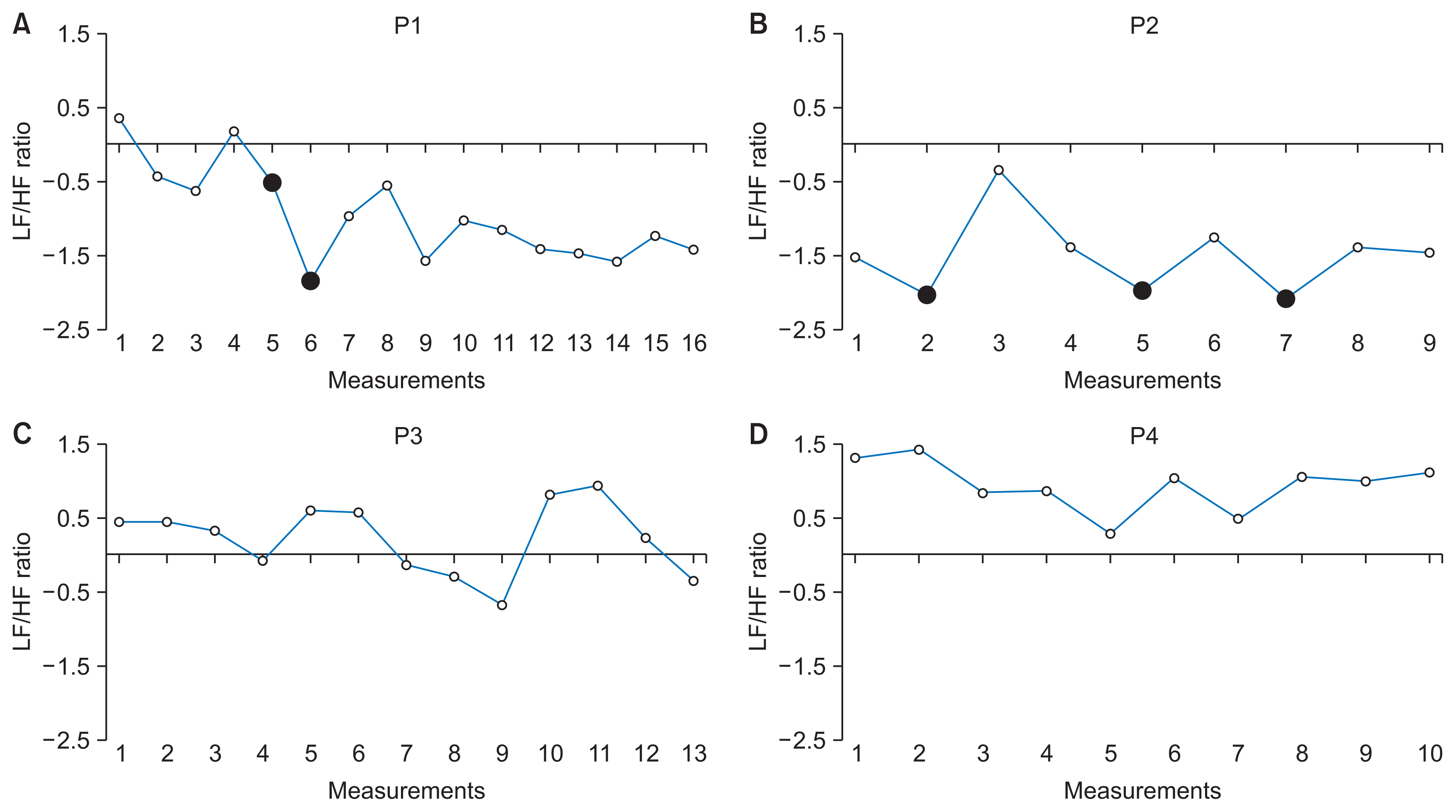Healthc Inform Res.
2021 Jul;27(3):249-254. 10.4258/hir.2021.27.3.249.
Heart Rate Variability as an Early Objective Indicator of Subjective Feeling of Depression in Daily Life
- Affiliations
-
- 1School of Computer Information and Communication Engineering, Kunsan National University, Gunsan, Korea
- 2Human Rights Center, Konkuk University, Seoul, Korea
- KMID: 2519041
- DOI: http://doi.org/10.4258/hir.2021.27.3.249
Abstract
Objectives
Changes in the autonomic nervous system have been observed in patients with depressive disorders by measuring their heart rate variability (HRV). However, whether HRV associates with depressive events in healthy people remains unknown.
Methods
Four healthy people participated in the present study. Their HRVs were measured routinely for 6 to 13 months. During this time, two participants reported experiencing two and three bouts of depression, respectively. This approach allowed us to examine changes in the participants’ HRVs by comparing their HRVs from before and after the unexpected depressive events. Changes in HRV were compared against those of two participants who did not report any depressive event.
Results
Participants’ low frequency/high frequency (LF/HF) ratios of HRV were lower after the event of depression than before. Their LF/HF ratios increased after recovery from the depressive events. In contrast, two participants who did not report any depressive event showed relatively smaller changes in their LF/HF ratios across measurements.
Conclusions
These results suggest that the LF/HF ratio may provide an objective measure of subjective experiences of depression and help identify potential cases of clinical depression.
Figure
Reference
-
References
1. Sgoifo A, Carnevali L, de Alfonso ML, Amore M. Autonomic dysfunction and heart rate variability in depression. Stress. 2015; 18(3):343–52.
Article2. Berntson GG, Bigger JT Jr, Eckberg DL, Grossman P, Kaufmann PG, Malik M, et al. Heart rate variability: origins, methods, and interpretive caveats. Psychophysiology. 1997; 34(6):623–48.
Article3. Malliani A, Lombardi F, Pagani M. Power spectrum analysis of heart rate variability: a tool to explore neural regulatory mechanisms. Br Heart J. 1994; 71(1):1–2.
Article4. Kemp AH, Quintana DS, Gray MA, Felmingham KL, Brown K, Gatt JM. Impact of depression and antidepressant treatment on heart rate variability: a review and meta-analysis. Biol Psychiatry. 2010; 67(11):1067–74.
Article5. Koch C, Wilhelm M, Salzmann S, Rief W, Euteneuer F. A meta-analysis of heart rate variability in major depression. Psychol Med. 2019; 49(12):1948–57.
Article6. Yeragani VK, Pohl R, Balon R, Ramesh C, Glitz D, Jung I, et al. Heart rate variability in patients with major depression. Psychiatry Res. 1991; 37(1):35–46.
Article7. Liang CS, Lee JF, Chen CC, Chang YC. Reactive heart rate variability in male patients with first-episode major depressive disorder. Prog Neuropsychopharmacol Biol Psychiatry. 2015; 56:52–7.
Article8. Licht CM, de Geus EJ, van Dyck R, Penninx BW. Association between anxiety disorders and heart rate variability in The Netherlands Study of Depression and Anxiety (NESDA). Psychosom Med. 2009; 71(5):508–18.
Article9. O’Regan C, Kenny RA, Cronin H, Finucane C, Kearney PM. Antidepressants strongly influence the relationship between depression and heart rate variability: findings from The Irish Longitudinal Study on Ageing (TILDA). Psychol Med. 2015; 45(3):623–36.10. Brown L, Karmakar C, Gray R, Jindal R, Lim T, Bryant C. Heart rate variability alterations in late life depression: a meta-analysis. J Affect Disord. 2018; 235:456–66.
Article11. American Psychiatric Association. Diagnostic and statistical manual of mental disorders (DSM-5). Washington (DC): American Psychiatric Association;2013.12. Heart rate variability: standards of measurement, physiological interpretation and clinical use. Task Force of the European Society of Cardiology and the North American Society of Pacing and Electrophysiology. Circulation. 1996; 93(5):1043–65.13. Beck AT, Ward CH, Mendelson M, Mock J, Erbaugh J. An inventory for measuring depression. Arch Gen Psychiatry. 1961; 4:561–71.
Article14. Beck AT, Epstein N, Brown G, Steer RA. An inventory for measuring clinical anxiety: psychometric properties. J Consult Clin Psychol. 1988; 56(6):893–7.
Article15. Chen HC, Yang CC, Kuo TB, Su TP, Chou P. Gender differences in the relationship between depression and cardiac autonomic function among community elderly. Int J Geriatr Psychiatry. 2010; 25(3):314–22.
Article16. Burger AJ, Charlamb M, Sherman HB. Circadian patterns of heart rate variability in normals, chronic stable angina and diabetes mellitus. Int J Cardiol. 1999; 71(1):41–8.
Article
- Full Text Links
- Actions
-
Cited
- CITED
-
- Close
- Share
- Similar articles
-
- The Changes in Heart Rate Variability between Morning and Afternoon
- Effect of Stress Level and Stress Vulnerability of Workers on Heart Rate Variability
- The Relationship among Depression, Self-esteem and ADL in the Case of the Hospitalized Elderly Patients with Chronic Disease
- Depression and Socio-Demographic Characteristics Associated with Quality of Life in the Community-Dwelling Elderly Living Alone
- Heart Rate Variability and the Efficacy of Biofeedback in Heroin Users with Depressive Symptoms


